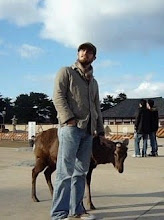Knee Deep in the Mud

For some people living in Japan means doing really traditional Japanese cultural activities like karate, judo, or learning how to properly dress in a kimono. Me, I basically live a very modern lifestyle here in Japan. I ride the bullet train, hang out in the downtown areas of the big cities like Osaka and Kyoto, and haven’t really learned any traditional arts. On my free time I usually play baseball, basketball and mini-soccer and go out to restaurants with my friends.
So last weekend when I was invited to go out into the fields and experience traditional rice field planting I thought it would be a good chance for me to experience some traditional Japanese culture. Every year the town teams up with a local farm to do an Agricultural Experience Tour. Its primarily aimed at families who have recently relocated from the big cities to live a more peaceful life in Seika. For most of these families who didn’t grow up in the country side it’s an opportunity for the parents and kids to experience traditional Japanese agriculture.
Seika Town was and still is a pretty traditional farming community. Even though there are now a lot of modern research facilities and tech companies in town there are still agricultural fields almost everywhere you look. During the winter all the rice fields were just left barren and dry, but starting last month they were all irrigated with water in preparation for rice planting. It’s a little strange to wake up one day and all the dirt fields are all of a sudden swamps. The cool thing is that frogs love the swampy rice fields so at night its really calming to listen to the croaking of the frogs outside of the window.
Being a city-boy I had no idea how rice planting works and I just figured that they throw out a lot of seeds into the freshly irrigated fields. But that’s not the way its done. First they germinate and grow the rice seeds in hot houses until the sprouts are about 8 inches tall. These days they have a handy tractor-like machine that takes a bed of rice sprouts and automatically distributes them evenly into the muddy fields. Since we went out to learn the traditional way of rice planting we didn’t use the machine and we all did it by hand. As I said before the once dry fields are flooded with water so that the dirt turns to mud and there is about 4 inches of water above ground level. We all went in barefoot and instantly sunk almost knee deep in the mud. It was a pretty weird feeling to be sunk in mud, especially since there are all sorts of unidentifiable clumps and odd textured things in the mud that you keep stepping on. I was just thankful that there didn’t seem to be any leeches in the water despite the swampy feel of it. From there you take about 3 rice sprouts and with your thumb and forefinger plunge them into the mud. You need to space them about 6 inches apart in a straight line so that once they are ready for harvest the harvesting machine can properly cut and collect the now 3 foot (1m) high rice plants.


There was about 50 people doing the tour, parents with their young children making up the majority of participants. It was funny because the kids were so typical, saying things like, “Eeeww, the mud is gross!” or “This is so boring.” So as you might expect after about 10 minutes of planting the rice most of the kids quit, wandered off, or starting looking for frogs to catch. This left the parents and me to finish up the job. With about 25 grown-ups it took us about an hour to plant the whole field.

I thought it was a cool experience and I filled my quota for traditional activities for the time being. I also got a bunch of the rice sprouts which I am taking home and I am going to try to grow them on my veranda in buckets. I wonder if it will actually work!?

Labels: agriculture, japan, rice

